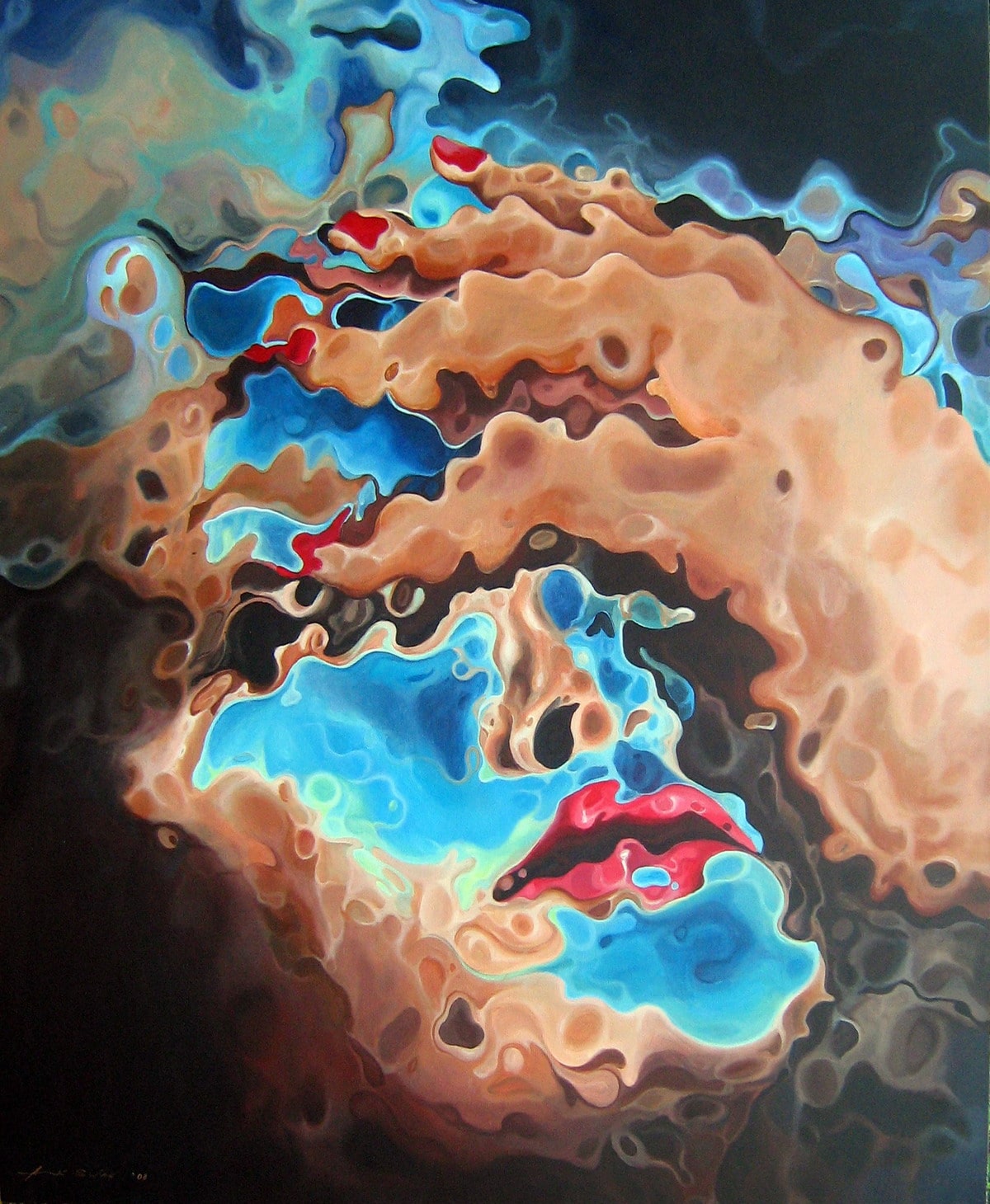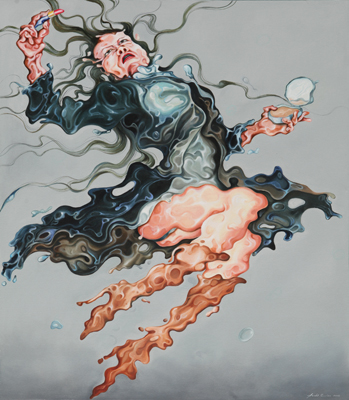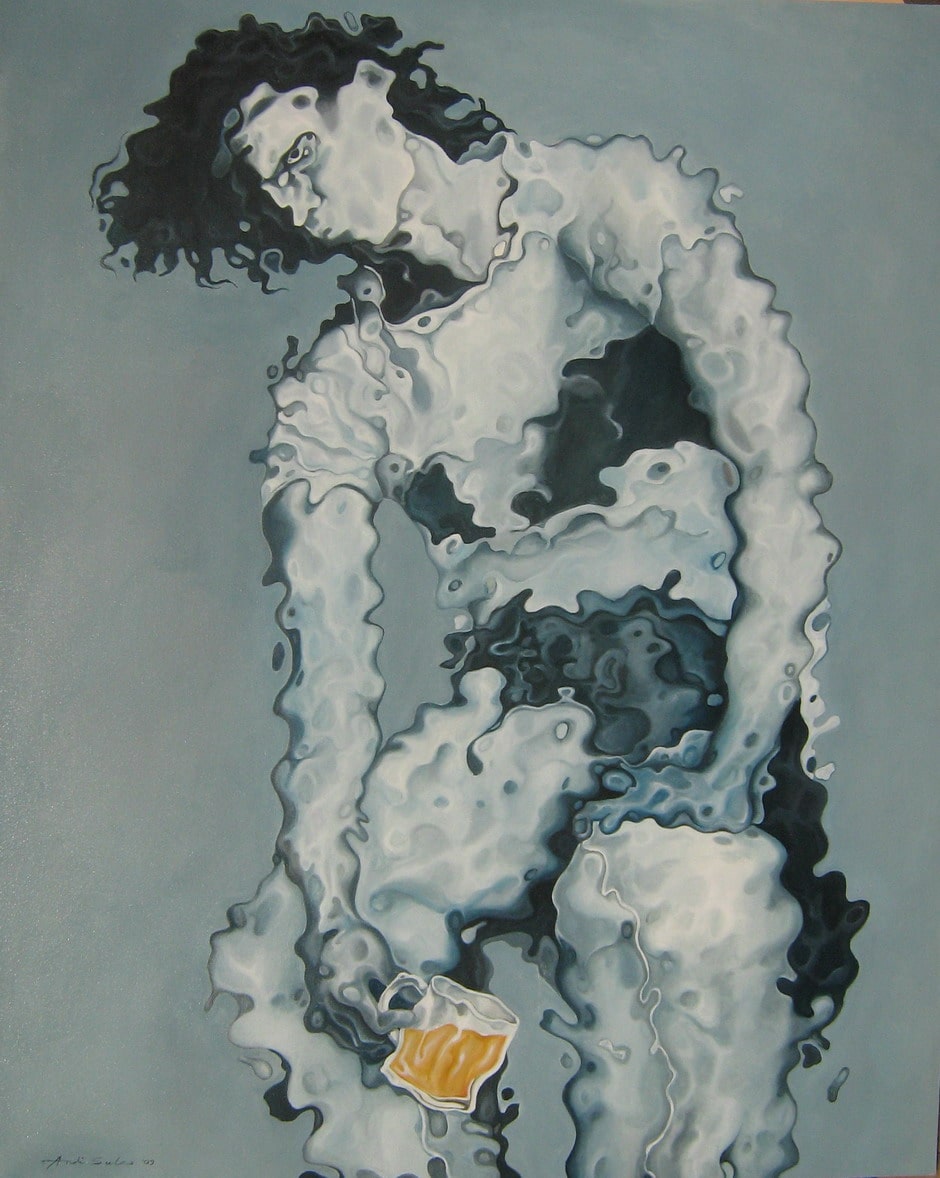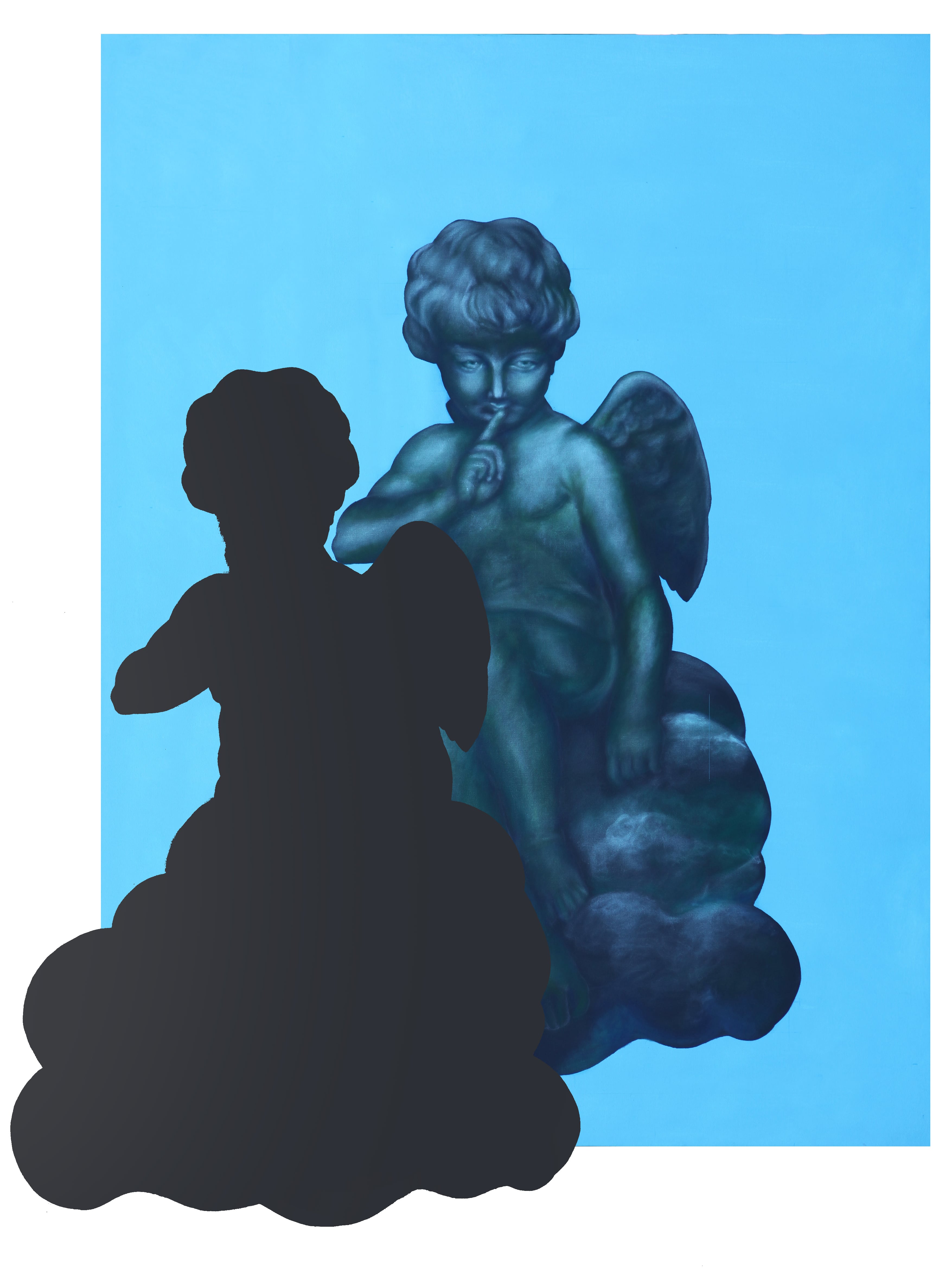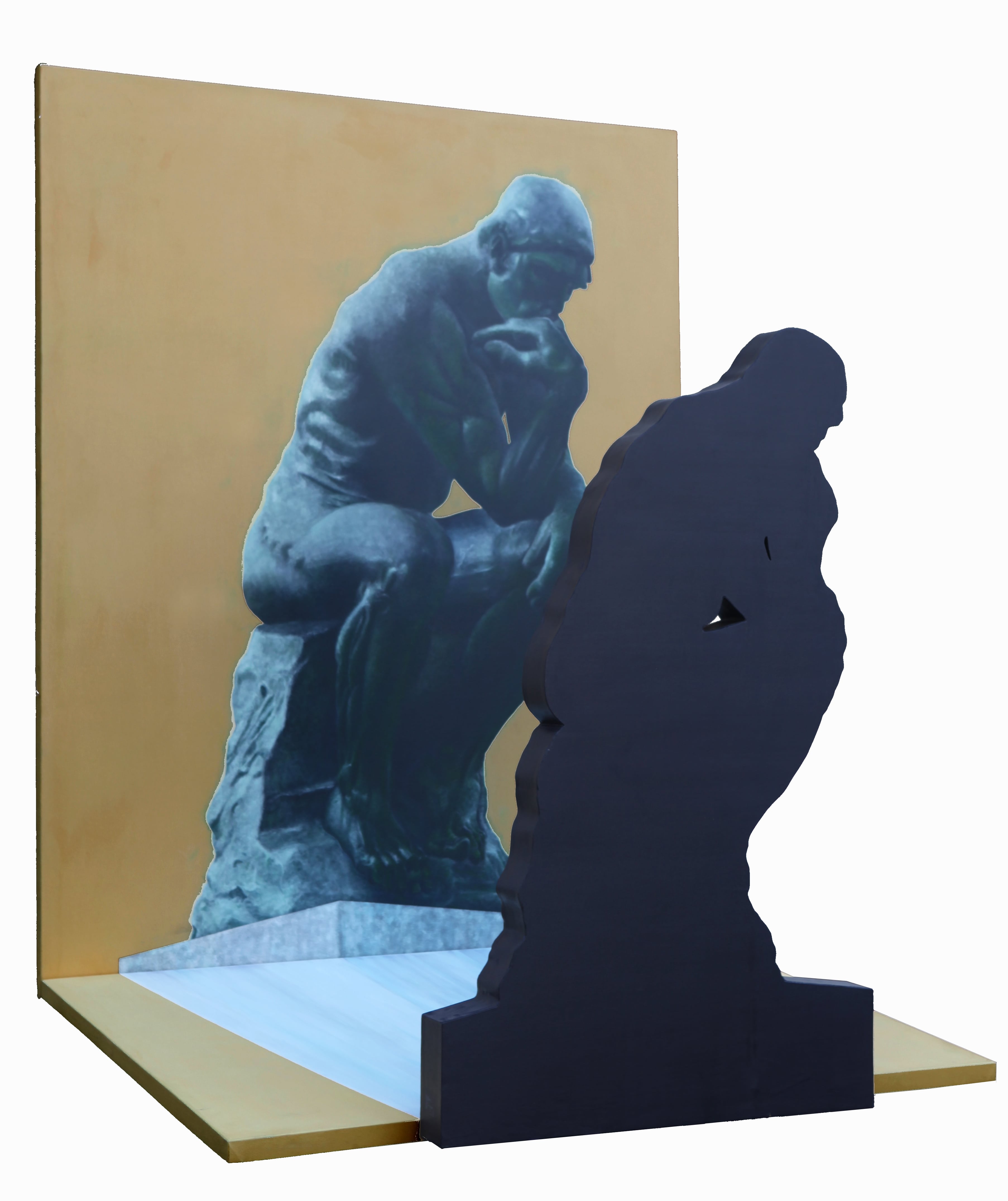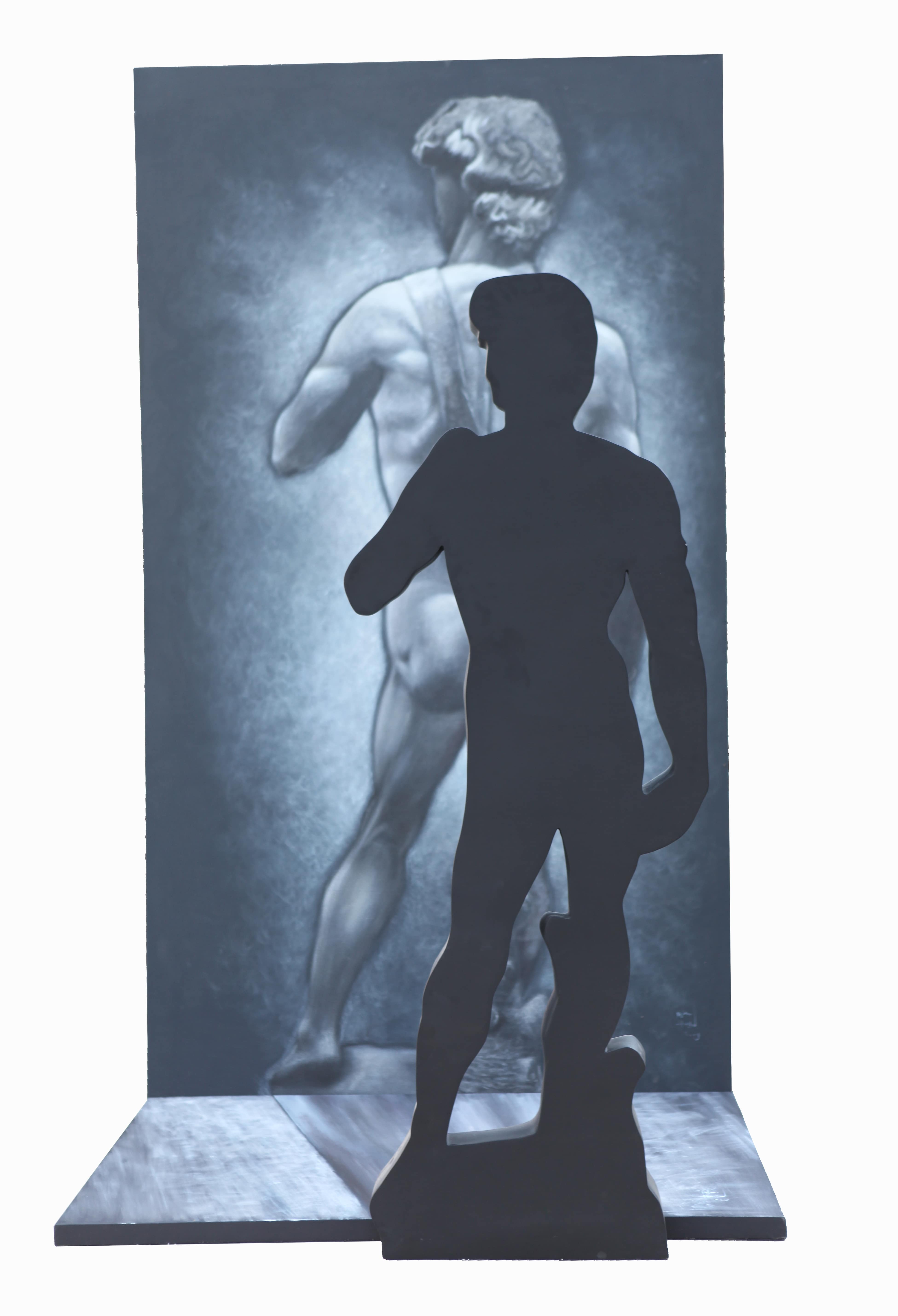Today, Andi’s Gallery presents works of two artists, both born in Central Java and formally educated at the same Art Institute in Yogyakarta, yet their characters and art approaches differ. They are Andi Sulistiyanto / Andi Sules ( born in Magelang, 23rd February 1973) dan Hasto Edi Setiawan (born in Semarang, 21st October 1974). Andi Sules based his painting on a reflection of water. He grew up in the area in between Yogyakarta and Magelang, a green town, close to water springs. He was used to living in cool areas, with mountain water flowing, so there are fishing ponds around. He was close to rural life where people are free to pick up fresh coconuts and to drink its milk direct. His father was a peasant, his mother was a retired Elementary School teacher. He enjoyed a peaceful village life that wrapped his childhood and his visual memory.
Meanwhile, Hasto came from a family living in an urban area of the city of Semarang, a society that culturally and relatively more varied, in which there have been interaction and cultural acculturation because they are closer to the north beaches of Java. It floods in the rainy season, and it is hotter compared to the weather in Central Java. Hasto’s father became a welder after retiring from a company of iron and steel in Semarang. Fire, iron, heavy machinery, and working with cutting and welding pieces and sheets of steel, measuring and constructing, are all daily realities that he absorbed everyday when he was a child. Hasto was the eighth son of nine children in the family, and he was prepared to take over his father’s business in the welding wokshop.
The social and cultural condition, geographical condition, and specific factors of the environment will have a strong impact on his visual language. For a visual artist, only specific factors that will give influence on his metaphorical expressions he chooses to actualize his ideas. The ideas are his world, his self, formed from his emotions, dreams, imagination, and his obsessions shown or hiden, and his will and other mental aspects that are interrelated to form his personality. From my personal discussion with Andi Sules on a house and its aspects to consider, should he buy a house, he skillfully answered with various arguments that the most important aspect of it is water, flowing and healthy water. In a discussion with Hasto, it was revealed that he has a rather complete vocabulary about machinery, and mechanics. He masters a great number of the vocabulary of technical terms explaining about how an engine works, and the details of cogwheels that move machinery. As an illustration about his technical tendency relating to his art works, are his works exhibited at Biennele Yogyakarta 2007 titled "New Nation" in the form of a bicycle of his own creation. Different from a common bicycle, his bicycle can only move forward when he cycles it backward. The gears are set anticlockwise. He engineered his bicycle by himself using used gears and manipulated exploratively with the experimental spirit.
The topography of visual world, sound, sense coordination and their logical patterns change when they are in different places, say, they now live in Yogyakarta where they absorb new things that are different from those they were familiar with. Both Andi Sules and Hasto studied at the Department of Fine Arts, Indonesian Institute of Art, Yogyakarta, and have been provoked by various aspects of their personality, such as point of view, their intellectualities, asethetics, and social and their cultural awareness. As artists struggling to establish their existence, they now do their creative works in Yogyakarta, where there are thousands active artists simultaneously working in a relatively small place to find their place in art.
Talking about ‘learning’ and one’s struggle in a dynamic place, a neorescientist, Norman Doidge, wrote that it is clear when we learn, we improve what we have alredy known. However, as futher stated by Merzenich, we also change the structure of our brain dan improve its capacity to learn..
Considering the journeys of both artist in their creative works, and observing their works, I may say that both have worked intensely to discover their specific identity. Andi Sules develops his painting conceptions from ideas that have been pick up purposively from various images, visual displays, daily phenomena represented in magazines, TVs, the internet, graphic displays in ad products and daily physical phenomena. He actualizes his art ideas through the figures specifically in the visual expresssions that give the impression of movement. His subject matters, whether they are humans or things drawn as a collection of moving fragments. Just like moving clouds that keep changing forms from time to time and become new forms.It seems that Sules’ painting portrays one moment of a phenomenon of a group of moving fragments. The figure in Andi’s painting is a moment from a frozen movement. He painted the fragment of movement in the form of human being with a contextual cultural attribute. His ideas of water and movement become his metaphorical materials.
Hasto, in the other hand, has the tendency to view various thing in a reverse point of view. He likes to turm over the logic, stereotype, and general understanding. The shadow of a thing or a figure that is optically two-dimentional, black and white with clear border is represented in such way that the illusion of dark and clear seems to be three dimensional. On the contrary, figure is presented in silhouette.
Fragments of movement
Andi Sules in one of his works titled Pencerahan ( The Enlightment) presents human figures borrowed from the famous statue, a masterpiece created by Auguste Rodin ( 1840-1917), The Thinker. In the whole, the works presents a figure of a man sitting and contemplating, his chin supported by his right hand rests on his thigh. But the surface of this figure is painted like water photographed and presented vertically. An impression is achieved of moving water in the open air, blown by the wind or caused by water that always flows into the lower areas.
His works titled Unity, 2009, picturing two hugging figures, united by love. The textures of their hand and body show that they are embracing each other passionately. As the above works of art, the representation of the subject matter of Unity also uses impression of movement, or like the presentation of figure in the moving water captured by a camera set for slow speed. This way, Sules seems to consider the figures he is painting via the moving water surface.
Andi Sules has done works outside the business of his studies at The Institure. He was admitted to the Institure, majoring in painting in 1995 and graduated in 2004. He used to work on the hotel interior, common houses, and others related in the interior works. The orders came from his clients, some of them were American and the Philliphine. They lended him magazines, catalogues, and designs, and paintings. His experience in working with his projects, directly and indirectly influences his artistic approach. He usually develops a picture processed in his computer so that he could manipulate the surface of the drawing, changed it, so that it looks like a moving object in the water that is photographed. Or like a human figure and moving objects photographed in low speed.
In fact, Andi Sules has a special interest in water. We know that he came from an area abundant with clean water, and also, he likes reading essays on water. He is impressed that the living body consists of 75% -80 % of water, and it never stay still and cannot be dammed, it is flexible and always adapts its place, liquid, and can easily be influenced. He uses his insight about water as a basic conceptions for his paintings. The exterior displays of a figure in Andi’s painting resembles the water of water installed vertically, so it gives the impresssion of a movement of water, or as a melting object, glowing of hot temperature. This kind of impression can be seen in his works titled Sun Burning, 2009, presenting a female figure sun bathing. Her body is glowing, moving, and warm, contrasted with the colour of blue sky in the background, and gray in the foreground. As a whole, the signs here say that he woman is sunbathing on the beach.
Making Shadow Solid
David I, by Hasto borrows form and impression from a masterpiece statue by Michelangelo titled David, created more than 500 years ago, sized more than 4 meters, made of whole alabaster, presenting David’s handsomeness, ready to fight against Goliath. In this painting Hasto draws a silhouette of David as painted so as it is projected on a canvas surface. The exclusiveness of Hasto’s works is by not making a two dimensional shadow. On the contrary, he makes the shadow representational, that is, the figure of David, front view.
David II, is formed from the same figure, but its shadow formed in David’s, figure rear view. This way, Hasto contradicts the general expectation. He executes his ideas for his paintings the way as he put the gears for his bicycle anticlockwise, to move forward he has to pedal it backwards. Other works of Hasto, The Thinker is created in the same way by borrowing the works of Auguste Rodin, The Thinker, (1879 – 89)..
His technical tendency in thinking of painting and making statues can be related to his educational background in the Junior High School. He studied at the Department of Electronics, Technical Junior High School, then he continued his studies in the Department Communication Electronics, the Technical High School. Here he studies Chains Operation to discover technical problem in an electronic chains. In Hasto’s terms, he studied trouble shooting by operating chains, analysized it, found the technical problem, then repaired it. Once he learned about the lift mechanism and learn about changing the rotation of a machinery, both electronically and mechanically.
Hasto’s father has trained him in various technical skills, especially related to welding business, hoping that he would take over his business. In 1996 he started studying at Yogyakarta Institute of Arts, at the Department of Handicraft, majoring in leather handicraft. Unfortunately, he felt that he could not find himself in the field. He needed challenges and opportunities to accept some surprises, that is why he moved to the Department of Fine Arts, majoring in statue in 1996. In this field he can develop himself, because he could make statue using any material. But, the economic presssure forced him to find a job outside fine arts in general. Hasto took jobs in various fields such as making baliho for campaign, designing garden for private enterprises, completing garden furniture; and creating stage back-drops. These influenced his creativity. He mastered technical skills. His works have strong and specific character. It is of no coincident that he was invited as a guest participant for an exhibition titled “Angkatan 1995” ( 1995 Generation) at Sangkring Art Space, though he was only a student, because the graduates of the Department of Fine Arts, 1995 generation, wanted to present the works of the students who were considered presenting fresh displays and chalenges and provoking. Then Hasto participaed by submitting his works using his present non conventional approach, i.e., by reversing the general expectation, and resisting practical logics. He has done all these using a conception of his own, i.e., practicing art means to poduce a product, real, having form, because for him, art is not the world of idea. Besides, he also considered art as language that makes it easier for him to work. His works are well considered, because he saw that there are so many competing works of arts, whether they are two dimensional, three dimensional, using video as media, and anything, he always tried to find different ways and strategies and particular to make his works considered. His conceptual strategy to present something specifically and prominently has been much influenced by the provocative works of a leading figure of Dada, Marcel Duchamp, who frequently makes use things discovered to present differently from the common.
What points can be Picked?
The two artists are only samples of many artists from different ages who, with their works try to say that only through deep observation and work intensity we can find what is specific and particular. What would imaginarily melts, both the common and the extraordinary, and moves, producing the potency to be given meaning. The shadows, in the case of Hasto’s works, may be viewed from different aspects. The shadows may be imagined as having thickness, or hollow, and may be presented in such a way that it represents the object then projected. The shadows can be imagined as a three-dimensional objects, can be viewed front view or profile. Andi Sules sees anything as moving, and is in the process of becoming. Or, anything seen as a mass that contains more than 70% water. The guitarist in his works Luapan Emosi,2009 (Emotional Oveflow ), in the eyes of Andi Sules is a mass of water, reacting, moving as a guitarist seen through a filter full of water heaves violently.
Hasto’s creative way to see the subject matter that he wants to carry out from different perspectives from the common, can be understood as a point for reflection.It is true that there so many findings caused by people who dare to view things differently, then research it to find if there are other undestandings that can be created.
Novelty, innovation, creativity and discovery require those who care to bravely move differently, imagining things in other ways, seeing things from unique point of views, feeling in an unfamiliar way, and exploring unexplored territories, not real and imaginary, and trying to engineer something that initially looks strange.
Talking about the works of the two artists exhibiting their works here, I want to say that Andi Sules has found a conceptual stepping ground that never fails to give new meanings when we observe intensively and sustainably, i.e., the ideas of the phenomena of movement and water. It would be sharper and having the power of excitation if Andi can be more explorative and experimental in presenting his subject matter. He can continuously dig various possibilities to present figures in balance that do not emerge from practical rationality to search for safety in composing his works. He has to try dynamic balance using unexpected displays. . Hasto has the courage to think anticlockwise, and explore various distinction. And yet he may stay static, let alone repeating his technical findings, because if he did so, he would be trapped in the mecahnism of reproduction. For the survival of his creativity, Hasto has to criticize, even to deconstruct, not only generally but also his own findings.


